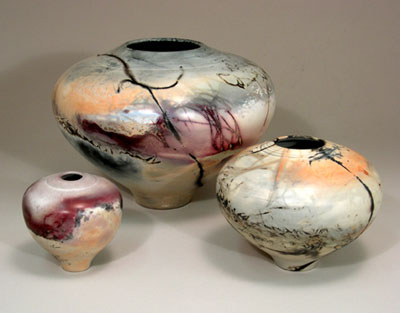

Pottery is the baked-clay wares of the entire ceramics field. For a description of the nature of the material, see clay.

Three types of firing
1. Electric Kiln
2. Gas Reduction Kiln
3. Pit Fire
Types of Pottery
It usually falls into three main classes—porous-bodied pottery, stoneware, and porcelain. Raw clay is transformed into a porous pottery when it is heated to a temperature of about 500°C. This pottery, unlike sun-dried clay, retains a permanent shape and does not disintegrate in water. Stoneware is produced by raising the temperature, and porcelain is baked at still greater heat. In this process part of the clay becomes vitrified, or glassy, and the strength of the pottery is increased.
Methods of Production
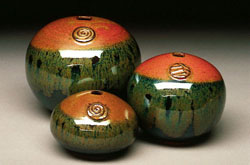
Pottery is formed while clay is in its plastic form. Either a long piece of clay is coiled and then smoothed, or the clay is centered upon a potter’s wheel (used in Egypt before 4000 B.C.) that spins the clay while it is being shaped by the hand, or thrown. Decoration may be incised, and the piece is allowed to dry to a state of leather hardness before firing it in a kiln. The type of finish, depending on the kind or number of glazes, dictates the total number of firings. When slip and graffito are used, they are applied before the first firing. There are two types of fires—reducing and oxidizing. The former removes oxygen while the latter, a smokeless fire, adds it. Reduction and oxidation change the color of the fired clay and gave early potters their palette of red, buff, and black.
History
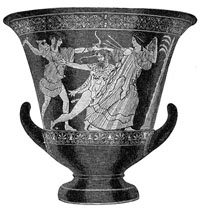
Early History
Pottery is one of the most enduring materials known to humankind. In most places it is the oldest and most widespread art; primitive peoples the world over have fashioned pots and bowls of baked clay for their daily use. Prehistoric (sometimes Neolithic) remains of pottery, e.g., in Scandinavia, England, France, Italy, Greece, and North and South America, have proved of great importance in archaeology and have often supplied a means of dating and establishing an early chronology. Pottery has also been of value as historical and literary records; ancient Assyrian and Babylonian writings have been inscribed upon clay tablets. Simple geometric patterns in monochrome, polychrome, or incised work are common to pottery of prehistoric and primitive cultures.
Pottery of the Ancient Mediterranean
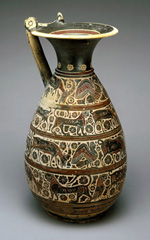
By 1500 B.C. the use of glazes, such as the famous greens and blues, was known in Egypt. Especially noteworthy is the early Aegean pottery of the Minoan and Mycenaean periods with its curvilinear, painted decoration. In Assyria and Neo-Babylonia, painted and glazed bricks were in common use. The Ishtar gate in Babylon, with its ceramic reliefs, is an early example of the majolica technique.
The Greek vases (800–300 B.C.), famous for symmetry of form and beauty of decoration, include red, black, and varicolored examples. The last were for tombs only, as the colors were painted, unfired, and easily marred. The red ware is decorated with black figures, or the ground is black and the figures shown red. Water, oil, and wine jars were numerous. Of the Greco-Roman wares, the Arretine or Samian, also a red ware, was molded after first being turned on the wheel to the size of the mold, which carried the decoration in intaglio.
Pottery of Asia

Painted pottery of the Neolithic period has been found in China. By the 2d cent. B.C. the Early Han period had developed a green glaze which may have come from the Middle East. In the Sui period (A.D. 581–618) and the T’ang period (618–906), porcelain and porcelaneous ware (the envy of the Western world) began to be made and exported to Korea and Japan and to the Islamic world. Technical knowledge, however, was not exchanged, and Islam made no true porcelain.
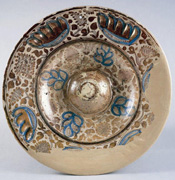
Islamic pottery making was centered at Baghdad in the 10th cent. Blue and green clear glazes were used, and lusterware was first employed as an overglaze. Lusterware was highly developed under the Fatimites in Egypt (969–1171), and the technique continued in use at major pottery centers over the centuries that followed. During the 13th cent. Mongol domination of Persia brought renewed Chinese influence to Islamic pottery making. Fine examples of Hispano-Moorish pottery date from the 14th cent. Islamic architecture in the 15th cent. utilized ceramic tile in immense quantities, as on the Blue Mosque at Tabriz.
Pottery of Europe
In Europe there was little pottery of great aesthetic importance before the 15th cent., except perhaps some German stonewares. Majolica was mainly developed in Italy and from there spread to Spain, France (where it was called faience), and to Holland (where it came to be known as delftware). Majolica and stoneware were the main pottery forms in Europe until the advent (18th cent.) of porcelain.
Pottery of the Americas
Prehistoric pottery found in Peru, Mexico, and the SW United States reveals a high degree of skill in color, form, and decorative motifs. Baked-clay work by colonists in North America began in 1612 with the making of bricks and tiles in Virginia and Pennsylvania. In these states and among the Dutch settlers of New York, potteries were soon established. The first whiteware was made in 1684. A stoneware factory was opened in New York in 1735, and c.1750 the Jugtown pottery of North Carolina was first produced. Terra-cotta works were operating in Massachusetts and Pennsylvania after the middle of the 18th cent. Palatinate refugees produced slip-decorated and graffito earthenware, and their product formed the foundation of Shenandoah pottery.
In Philadelphia fine china was made (1769) for the first time in America. The potteries of Bennington, Vt., which opened in 1793, were known especially for their stoneware jugs; a variety of stoneware was also produced in several locations in New York state. East Liverpool, Ohio, since 1839 one of the foremost centers of the industry, produced the first American Rockingham ware. Also widely produced in the United States were redware, ironstone, and yellowware. Another center, begun in 1852 at Trenton, N.J., made fine Belleek or eggshell china. The Centennial Exposition of 1876 in Philadelphia and the World’s Columbian Exposition of 1893 in Chicago did much to awaken native consciousness of pottery as a form of art.
Modern Pottery
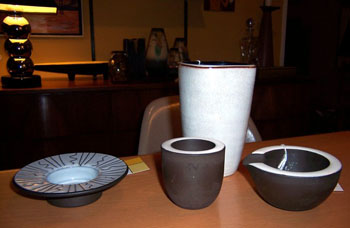
In spite of the development of mass-production techniques and synthetic materials, the demand for hand-crafted ware of fine quality has not diminished. A variety of artisans make utilitarian objects as well as works of art using many methods of pottery production. Moreover, indigenous peoples, notably native Americans, continue to create a number of vessels adapted from traditional forms. In addition, many of the major artists of the 20th cent. have created exquisite ceramic works. Especially notable are those by Picasso, Matisse, and Miró. 12
Bibliography
See L. A. Boger, The Dictionary of World Pottery and Porcelain (1970); W. E. Cox, Book of Pottery and Porcelain (2 vol., rev. ed. 1970); E. Cooper, A History of Pottery (1973); G. Savage and H. Newman, An Illustrated Dictionary of Ceramics (1974); R. Fournier, The Illustrated Dictionary of Pottery Decoration (1986).































